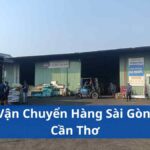Hundreds of trucks carrying fresh flowers and Vietnamese agricultural products are experiencing long days stuck at the Tan Thanh border gate in Lang Son, creating a heartbreaking scene of “trucks carrying flowers lined up waiting to enter the market.” This prolonged congestion not only causes significant economic damage to gardeners and transport businesses but also affects the quality of export goods, especially fresh flowers – a commodity that is very sensitive to time.
 Trucks carrying flowers and agricultural products lined up at the Tan Thanh border gate due to congestion.
Trucks carrying flowers and agricultural products lined up at the Tan Thanh border gate due to congestion.
According to information from authorities, the main reason for this situation is that China only clears about 250 vehicles per day, while the number of vehicles carrying agricultural products, especially fruits and fresh flowers, arriving at the border gate reaches 700-800, especially during the Lunar New Year. This creates a large imbalance, causing hundreds of trucks carrying flowers and other goods to “line up waiting to enter the market,” stretching for dozens of kilometers.
Causes of Flower Truck Congestion at Tan Thanh Border Gate
The congestion at Tan Thanh border gate is not a new problem, but it has become more serious at this time due to many contributing factors:
- Restrictive Import Policies from China: China applies quite strict import control policies on agricultural products, fruits, and fresh flowers, especially at the Tan Thanh border gate – the only border gate allowed to import fresh agricultural products into this populous market. Limiting the number of vehicles cleared each day makes the accumulation of goods inevitable.
- Sudden Increase in Goods Flow: The time near the Lunar New Year is the peak season for exporting agricultural products, fruits, and fresh flowers to China. Increased consumer demand leads to a sharp increase in the amount of goods arriving at the border gate, exceeding the clearance capacity of the border gate.
- Strict Inspection Procedures: The Chinese side strengthens the inspection of the quality and origin of goods, especially agricultural products, fruits, and fresh flowers. The lengthy inspection process, coupled with the limited number of customs officers, further slows down the clearance process, causing congestion.
- Weather Factors: The cold weather in China also affects the consumption rate of fruits and fresh flowers, causing Chinese owners to choose goods more carefully, even returning goods, slowing down the clearance process.
Severe Damage to Flower and Agricultural Product Trucks
The situation of “trucks carrying flowers lined up waiting to enter the market” is not only a painful image but also causes enormous damage to related parties:
- Reduced Quality of Fresh Flowers and Agricultural Products: Fresh flowers are easily damaged if not properly preserved and transported in a timely manner. Having to “line up waiting to enter the market” in harsh weather causes flowers to wilt, lose value, and even become unexportable. Other agricultural products such as vegetables and fruits are also affected in quality, reducing competitiveness.
- Increased Transportation Costs: Flower trucks have to run air conditioners continuously to preserve fresh flowers, consuming a large amount of fuel. The cost of accommodation and living for drivers during the waiting days also increases significantly. Car owners and transport businesses have to bear many additional costs, affecting profits.
- Loss of Business Opportunities: Prolonged congestion prevents many shipments of fresh flowers and agricultural products from reaching the Po Chai wholesale market (China) on time, missing the best sales opportunity, especially during the Lunar New Year. This causes revenue loss and affects the business plans of gardeners and businesses.
- Impact on Reputation: Failure to ensure quality and delivery time may reduce the reputation of Vietnamese agricultural products and fresh flowers in the international market, making it difficult to export in the future.
 Trucks carrying agricultural products stuck at the Tan Thanh border gate, causing economic damage.
Trucks carrying agricultural products stuck at the Tan Thanh border gate, causing economic damage.
Necessary Solutions for Congestion
To solve the situation of “trucks carrying flowers lined up waiting to enter the market” and general border gate congestion issues, synchronous and drastic solutions are needed from both Vietnam and China:
- Diplomatic Negotiations: The Vietnamese government needs to continue to negotiate with the Chinese side to increase clearance time, increase the number of vehicles allowed to be cleared each day, and expand more border gates for importing agricultural products, fruits, and fresh flowers.
- Upgrading Border Gate Infrastructure: It is necessary to invest in upgrading the infrastructure of the Tan Thanh border gate, expanding the area of wharves and yards, and strengthening inspection and monitoring equipment to improve clearance capacity.
- Optimize Procedures: Functional agencies need to coordinate to review and simplify customs and quarantine procedures, minimizing waiting time and costs for businesses.
- Diversify Export Markets: Businesses and gardeners need to actively seek and expand export markets to other countries, reducing dependence on the Chinese market, avoiding passivity when there are policy changes from the other side.
- Improve Product Quality: To meet the increasing requirements from the Chinese market and other markets, it is necessary to focus on improving the quality of agricultural products, fruits, and fresh flowers, ensuring standards of food safety and hygiene, and traceability.
Conclusion
The situation of “trucks carrying flowers lined up waiting to enter the market” at the Tan Thanh border gate is an urgent issue that requires joint efforts to resolve from many parties. Finding effective solutions not only helps reduce economic damage to businesses and gardeners but also contributes to promoting the sustainable and stable development of Vietnamese agricultural product and fresh flower exports in the future. In order for “flower trucks” to no longer have to “line up waiting to enter the market,” there needs to be close cooperation and goodwill from both Vietnam and China, along with innovation efforts from businesses and gardeners themselves.

